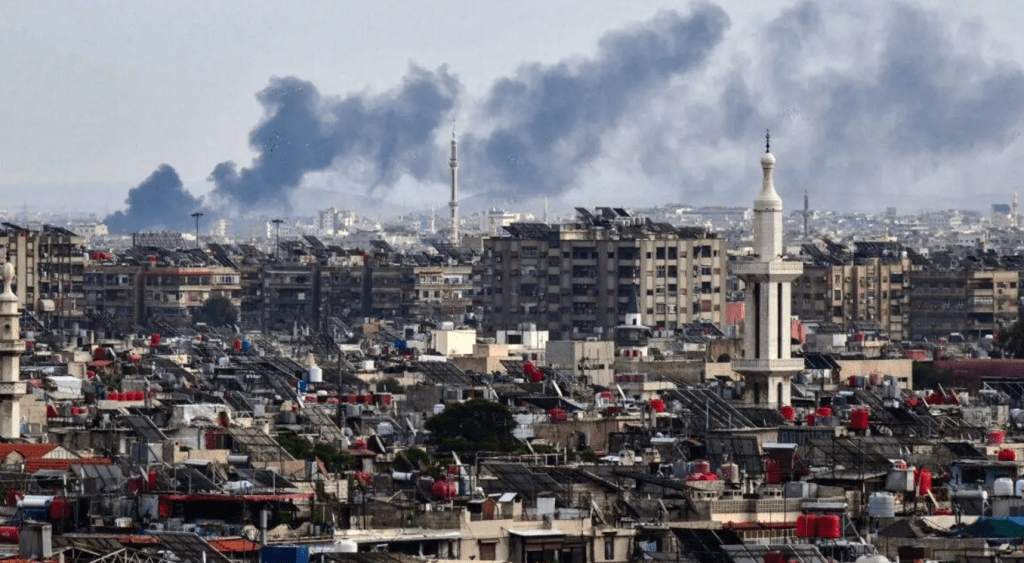Environmental Impact of the Attacks on Gaza
The military actions in Gaza have resulted in widespread environmental degradation, particularly through the destruction of buildings, infrastructure, and natural resources. Heavy artillery, bombs, and white phosphorus shells have led to substantial carbon emissions.
According to a study by Queen Mary University in London, between January and April 2024, the emissions reached between 420,000 and 652,000 tons of CO2—equivalent to the total annual emissions of 26 countries combined.
The use of white phosphorus, which is prohibited in densely populated areas under international law, is particularly concerning. Its long-lasting effects include contamination of soil and water, initially killing vegetation and later promoting excessive growth of plants and algae.
These changes disrupt local ecosystems, presenting long-term environmental challenges.
In addition to atmospheric pollution, the destruction of Gaza’s infrastructure has caused a critical shortage of clean water. As of the first eight months of 2024, around 67% of water and sanitation facilities in Gaza were destroyed, worsening the humanitarian situation.
Residents now have access to only a fraction of the water they need. Reports from Oxfam indicate that Gaza’s residents are now using just 4.74 liters of water per person daily, far below the 15 liters typically required in emergency situations.
The destruction of infrastructure, coupled with mass displacement, exacerbates the environmental and health challenges.
Waste Accumulation and Disease Outbreaks in Gaza


The widespread destruction has also led to the accumulation of waste, including medical and chemical waste, which has further compromised Gaza’s already weakened environment.
According to the Dutch NGO PAX for Peace, hundreds of thousands of tons of solid waste have accumulated, including building rubble, broken infrastructure, and damaged vehicles.
This waste contributes to the spread of diseases such as Hepatitis B and C, as chemicals and untreated medical waste seep into the soil and groundwater.
The ongoing reconstruction of Gaza poses another environmental concern. The United Nations estimates that rebuilding the region could release up to 60 million tons of CO2, which is equivalent to the annual emissions of several countries, including Sweden and Portugal.
This alarming forecast underscores the significant environmental toll the conflict has taken and the long road to recovery.
Broader Regional Impacts on the Environment


Military actions across the MENA region have also intensified environmental challenges, further destabilizing the region’s fragile ecosystems.
In Lebanon, airstrikes and incendiary weapons have destroyed agricultural lands and ecosystems, particularly in southern Lebanon and the Beqaa Valley, contributing to soil degradation and air pollution.
In Yemen, attacks on Red Sea shipping lanes and fuel infrastructure have caused oil spills and pollution, endangering coral reefs, mangroves, and fisheries while increasing greenhouse gas emissions.
In Syria, the destruction of industrial and energy facilities has led to severe ecosystem degradation, with long-term risks to public health. Iraq, frequently targeted for its oil infrastructure, faces ecosystem destruction and cross-border pollution risks, particularly along the Shatt al-Arab River.
In Iran, attacks on oil and nuclear facilities have the potential to cause widespread environmental damage, including radioactive contamination.
Throughout the region, weak environmental governance and the destruction of critical infrastructure have exacerbated issues such as water scarcity, waste management, and air quality. These environmental impacts threaten natural resources and ecosystems, further undermining the health of millions across MENA.
To address these issues, political will and financial resources are essential, along with technical expertise and training from multilateral organizations and foreign governments. Education and awareness campaigns are also crucial for engaging marginalized communities in environmental protection efforts and promoting a just, sustainable future for all.
We Also Said: Don’t Miss It…Beirut Under Fire Again: Israel’s Latest Airstrikes Amid Ongoing Geopolitical Tensions



